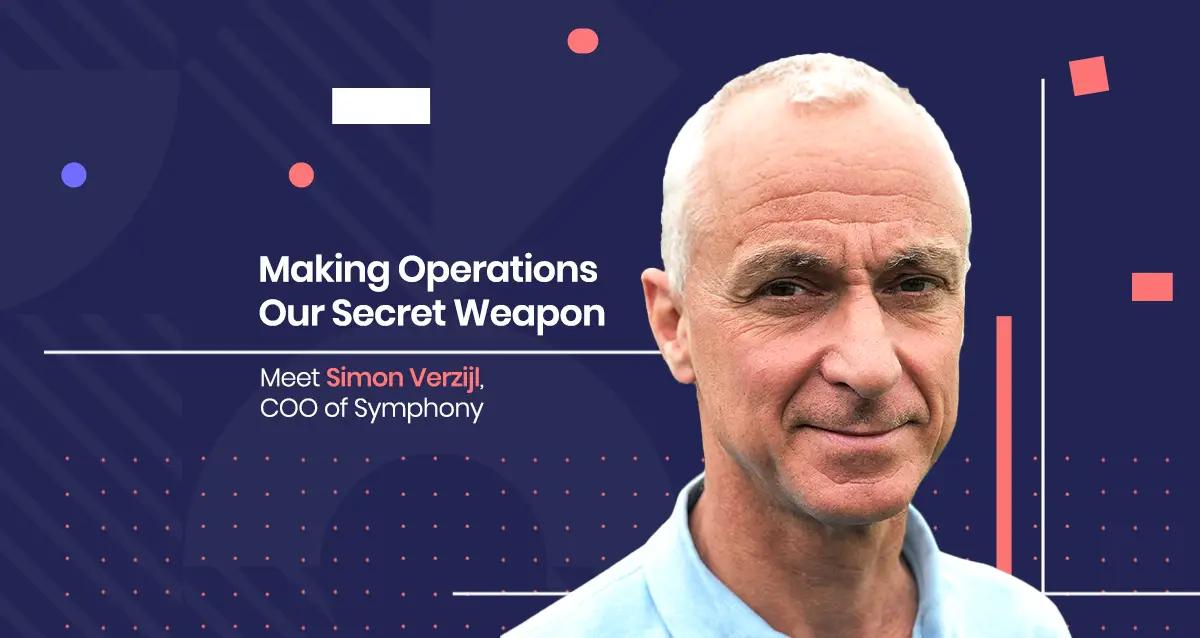In the last couple of years, Symphony has seen tremendous growth across all its departments and functions. Just last year, amid the global pandemic, we successfully opened another engineering hub in Serbia and significantly grew our workforce in all regions. And we only see this as a beginning.
To achieve our long-term business goals, we want to implement and scale operational changes a lot faster and in line with our growth. Simon Verzijl joined Symphony a couple of months ago as the COO with a mission to help Symphony work smarter and make operations our secret weapon.
Bringing EVP experience from Xerox and know-how of managing 47k employees
Having extensive and robust professional experience doesn’t come without a great story to share. With more than 30 years of experience, Simon Verzijl joins Symphony at a pivotal time to give us greater leadership capacity. With Simon’s help and expertise, we plan to cover more ground, assess more opportunities, and speed up decision-making to best serve our clients and partners.
With a Master’s Degree in Mechanical Engineering from Delft University, Simon Verzijl joined Accenture in a quest to focus his career path on business development and consultancy. “During my studies at Delft University, I realized that I am much more interested in business processes and outputs than mechanical engineering,” Simon openly shares. During his ten years at Accenture, he specialized in the production and logistics areas of consultancy. At the beginning of the millennium, he was faced with a difficult choice - continue his career at Accenture and aim for a Partner position or start his own company. “This was the time of the dot-com bubble, and a lot of my friends and acquaintances have started their own companies with a lot of success. I decided to start my own company focused on handling incoming emails, as this was the new and popular way of communication back then” Simon starts his story. The first part of his business model was based on how call centers work with incoming calls, with his company helping businesses from various industries sort and answer their incoming emails in a proper and timely manner. The second part of the business model was focused on using artificial intelligence and neural networks where the system would self-learn. After some time, it would take over the complete process of answering emails. “The first part of the model was an obvious success, but the second part was happening a bit too early for the available technical possibilities. A couple of years later, we were able to migrate my first company with a larger contact center. I became the company CEO, and a couple of mergers later, we had over 3,000 employees, and we were successfully operating in countries like Netherlands, Belgium, Turkey, and the Czech Republic,” continues Simon. A new chapter in his career began when Xerox approached him with a proposal to acquire the company. A year earlier, Xerox acquired a large stock-listed BPO company from the United States, and their next step was to grow that business on the European market. “Our decision to sell the company was based on purely technical reasons - we hit the ceiling, and the only way for us to continue our growth and expansion was to join a bigger company.” Simon’s company was the first one they acquired in Europe, and a couple of mergers later, Simon was leading more than 10,000 people in Europe. Thanks to his extraordinary success rate in Europe, his next step was to take the lead of the global department with more than 100 offices and 47,000 employees all over the world.
Leading the biggest department in a global enterprise didn’t come without a couple of sacrifices. At that time, Simon felt disconnected from the company and employees because he spent most of his time on planes traveling from one location to another. After a couple of years, he moved to the leading digital growth consultancy and fastest-growing management consultancy firm in Europe as CEO.
The Story About Cyclists Going Through a Tunnel at Full Speed
The one thing that Simon likes to emphasize is the importance of employees and their impact on the company’s growth. When the company’s leadership wants to make a change in the organization, a good business plan and strong business case aren’t always sufficient. Employees and their resonance are critical. Explaining everything in detail and constantly checking if people are on board is crucial in implementing any change within the organization. It takes time to really help people understand where the company is going, and this phenomenon is quite similar to the group of cyclists going through the tunnel at full speed. If you aren’t looking back and seeing if other cyclists are following you, you’ll be the only one coming at the end of it.
When asked about motivation in a large group of employees, Simon explains that motivational factors are different for everyone. He points out that people can be factual, output-driven, or very analytical. Still, there’s always an emotional side within all of these layers that impacts the way we interact with our managers, colleagues, and customers. Only by closely listening to employees, a company can learn all dimensions of their motivation and, through recognition and empowerment, help them succeed.
When asked about his motivation, he explains that looking back and seeing things have improved drives him to achieve more. “In a large company, it’s tough to see the impact you’re making on the people around you. That’s why I like companies like Symphony, which are in the perfect position to improve how things operate and create a smooth operating machine while keeping the connection to the employees.” To achieve this, Simon openly states that delegative leadership, also known as "laissez-faire leadership" really helps him achieve his goals within the organization. In his work with close stakeholders, he lets them find their own best way to do their thing, but the outcome of each decision should be aligned with the company’s goals. Since joining the company, he implemented a short but very effective check-in method within departments called “Flash Calls.” During these 30-minute meetings, each participant shares the most recent performance indicators of their team, without too many details, just to check if their work is aligned with the company’s goals. If needed, additional consultation is organized separately, as those meetings are meant to be fast and analytical.
Starting a New Chapter with Symphony - The Future Looks Bright
As mentioned above, Symphony’s current phase fits perfectly into Simon Verzijl’s favorite position to be. With its current pace of growth, Symphony is very close to moving past 1,000 employees, and by then, the structure and processes should already be in place. Simon’s primary responsibility is to create a scalable organizational design that will support the company’s growth. Building a scalable organization means covering each department, from finances to engineering to delivery and internal operations. “To be able to do my job properly, I need a lot of room and empowerment to steer the organization in a new direction and implement the changes. A great thing here is that from my first meetings with Symphony’s CEO, I realized that he is very aware of the situation we are in. Having him on board and open to making these big changes was a crucial factor for me to join Symphony in the first place.”
During his first couple of months at Symphony, Simon has already had an opportunity to meet and closely work with all the relevant stakeholders. “In my experience, there is always a resistance to change. Here at Symphony, the situation is completely different. People are open-minded and eager to make a change - they are motivated, ready, and determined but they are lacking direction and experience. Seeing that people are willing to push the company’s agenda above their own is quite different from what you usually see in other organizations. The culture within the company makes it an absolute pleasure to be a part of Symphony.”
The upcoming period for Symphony will be pretty different from anything we have done before. We are ready to continuously adapt to our growth and become even more flexible with everything that the future brings. Symphony is moving to another phase of its service offering by taking more ownership of the solutions we are building. “We will not only create something that the client is asking for, but we will also solve their business problems. We plan to add more consultancy services and become a consultative provider to our clients. That also means setting up new departments and roles within the organization, and we’re looking forward to entering this phase. Regarding our presence on the global market, we’re expanding to new geographical regions - we’re actively increasing our business presence in Europe and building new engineering hubs in countries like Romania, Poland, and Turkey.“ concluded Simon Verzijl, with a firm promise that the future looks bright for Symphony.


-1.png&w=3840&q=50)
-1.png&w=3840&q=50)
-1.png&w=3840&q=50)